Looking for an authentic Bolognese sauce recipe? Dive into our step-by-step guide and learn how to create a mouthwatering and easy bolognese recipe that elevates your pasta dishes to a whole new level of flavor.

When it comes to classic Italian comfort food, a rich and hearty Bolognese sauce takes the spotlight.
The blend of tender meats, aromatic vegetables, and luscious tomatoes are all simmered to perfection in this recipe for bolognese sauce.
Whether you’re seeking comfort on a cozy evening or aiming to impress guests with a taste of authentic Italian cuisine at a dinner party, our step-by-step guide to making an easy bolognese sauce will lead you through the art of crafting this rich and flavorful sauce.
What is Bolognese Sauce?
Bolognese is a traditional Italian pasta sauce. A classic bolognese sauce is slow-cooked with a blend of ground meats like beef and pork, sautéed with aromatic vegetables like onions, carrots, and celery. This meaty sauce is known for its slow-cooking process, which allows these ingredients and flavors to simmer together to meld and develop into a rich and savory sauce. This hearty sauce is typically served with pasta and is a staple of Italian cuisine.

What is Bolognese Meat Sauce Made Of?
Bolognese meat sauce, or ragù bolognese, consists of ground beef and pork. Aromatic vegetables like onions, carrots, and celery are sautéed, while tomatoes offer acidity and color. The addition of herbs and spices like bay leaves and nutmeg, and occasionally wine, are all slow-cooked to create a rich, complex sauce.
How to Make Bolognese Sauce
Ingredients:
- 1/2 pound ground beef
- 1/2 pound ground pork
- 1 onion, finely chopped
- 2 carrots, finely chopped
- 2 celery stalks, finely chopped
- 3 cloves garlic, minced
- 1/2 cup red wine (optional)
- 1 cup beef broth or chicken broth
- 1/4 cup milk or cream
- 1 can (14 oz) crushed tomatoes
- 2 tablespoons tomato paste
- 1/2 teaspoon nutmeg
- 1 teaspoon dried oregano
- 1 teaspoon dried basil
- 2 bay leaves
- 1 teaspoon dried thyme
- Salt and black pepper to taste
- Olive oil
- Freshly grated Parmesan cheese (for serving)
- Fresh basil or parsley (for garnish)
- Wide pasta (tagliatelle, pappardelle, or fettuccine)

Instructions:
Heat a few tablespoons of olive oil in a large pot or dutch oven over medium-high heat. Add the chopped onion, carrots, and celery. Sauté until the vegetables are softened and the onion is translucent, about 8-10 minutes.
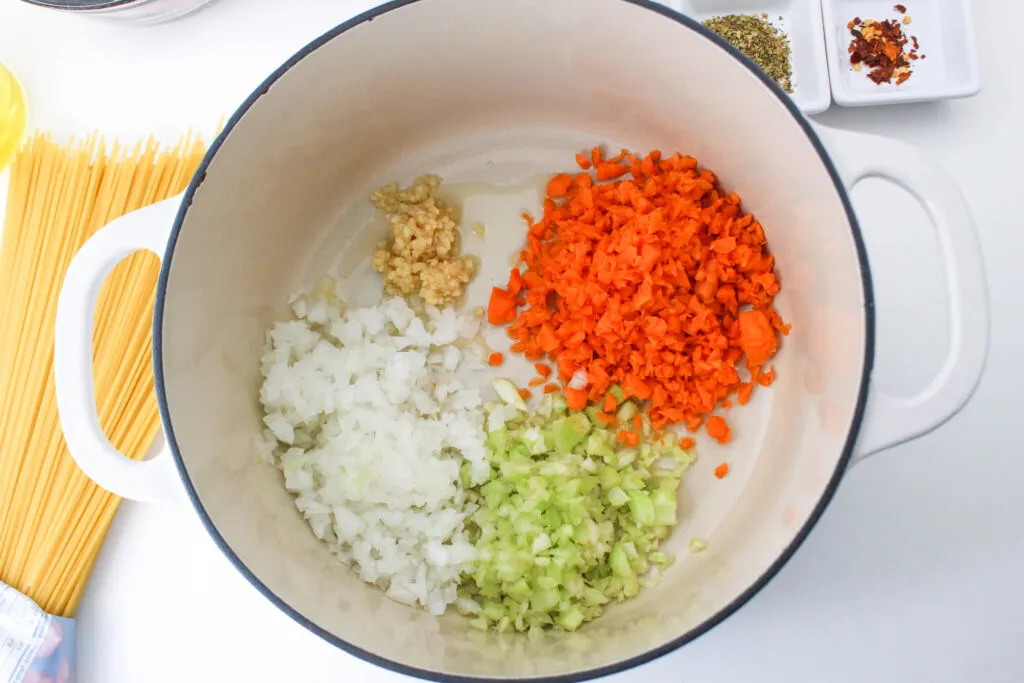
Push the sautéed vegetables to the side of the pot and add the ground beef and pork. Break up the meat with a wooden spoon and cook until nicely browned and cooked through. Combine the meat mixture with the sautéed vegetables.

Clear a space in the center of the pot and add the tomato paste. Allow it to cook for a minute or two to develop its flavor.
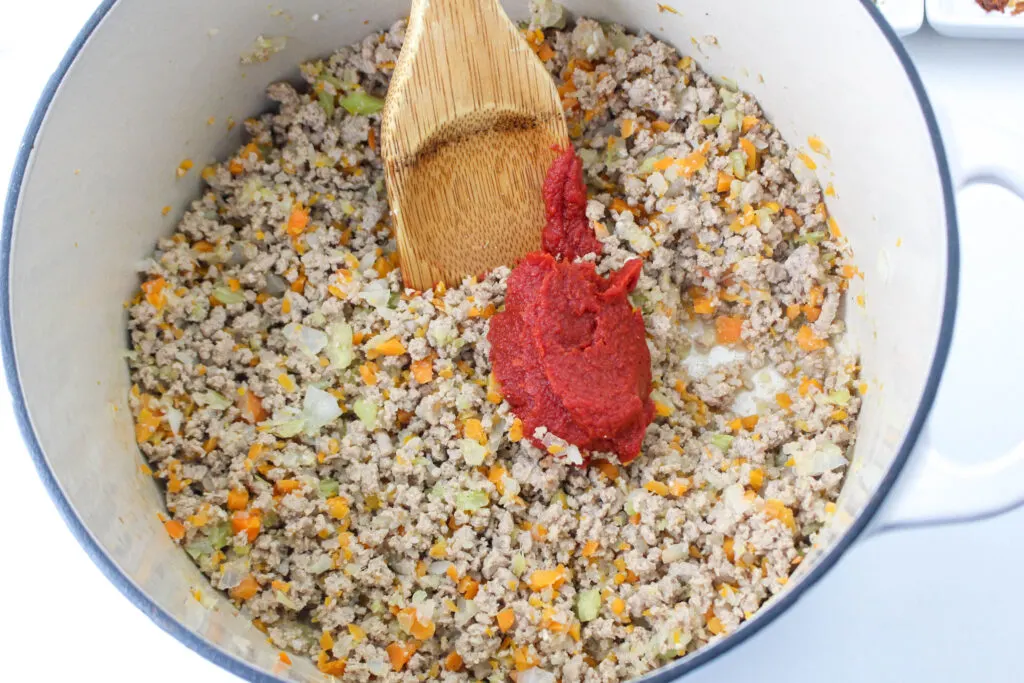
If using wine, pour it into the pot and use a spoon to scrape up any browned bits from the bottom of the pan. Allow the wine to simmer and reduce slightly.
Add the crushed tomatoes and broth to the pot. Stir to combine everything. Add the bay leaves, oregano, basil, dried thyme, nutmeg, salt, and black pepper. Lower the heat to a gentle simmer.

Gradually pour in the milk or cream, stirring as you do so. The milk helps mellow the acidity of the tomatoes and adds richness. For at least 2-3 hours, cook on a very low simmer, stirring occasionally to prevent sticking.

While the sauce cooks, cook the pasta according to the package instructions. Drain and set aside.
Before serving, taste and adjust the seasoning as needed. Remove the bay leaf. Serve the sauce over the cooked pasta.
Sprinkle freshly grated Parmesan cheese and chopped basil or parsley over each plate before serving.
Serve the Bolognese sauce over a pile of perfectly al dente pasta, garnish with grated Parmesan and fresh herbs.
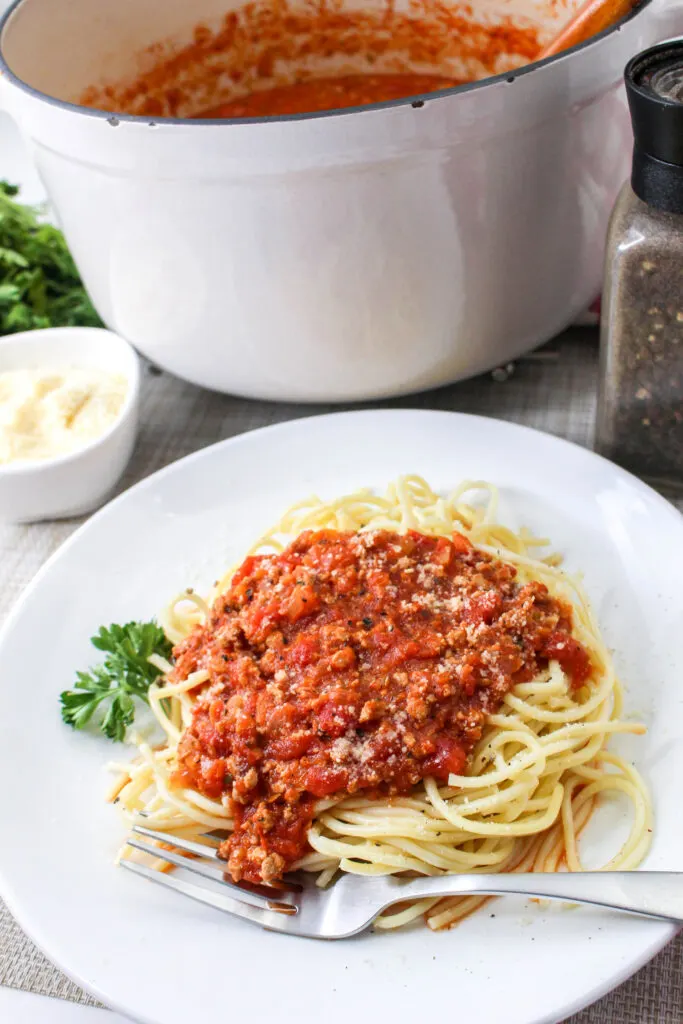
And don’t forget about a loaf of crusty bread to dip in your sauce!
Store leftover sauce in an airtight container.

What Is The Best Pasta for Bolognese Sauce?
While you can use your favorite pasta, the best pasta for Bolognese sauce is one that can hold up to the richness and complexity of the sauce while providing a satisfying bite. A pasta shape that is wide and flat such as tagliatelle, pappardelle, or fettuccine, are ideal choices. These pasta varieties offer a larger surface area for the sauce to cling to.

Tips for Making Bolognese Sauce Recipe
- Opt for high quality ground meats like beef and pork and fresh and aromatic vegetables, such as onions, carrots, and celery, to contribute to the sauce’s depth of flavor.
- Bolognese sauce is all about patience. Simmer the sauce on low heat for an extended period, allowing the flavors to meld and develop into a rich and complex profile.
- Sauté the finely chopped onions, carrots, and celery in olive oil or butter until they’re soft and fragrant. This aromatic base sets the foundation for the sauce’s flavor.
- Brown the ground meats separately. This step adds depth and ensures the meats are evenly cooked before combining with the vegetables.
- Use a combination of canned tomatoes or tomato paste and fresh tomatoes if available. This blend provides both deep tomato flavor and the necessary acidity to balance the richness of the meats.
- Bay leaves, thyme, and a hint of nutmeg enhance the sauce’s complexity. Use them sparingly to avoid overpowering the other flavors.
- A splash of red wine adds an extra depth of flavor.. Choose a wine you enjoy drinking, as its flavors will concentrate during cooking.
- Remove bay leaves before serving. Consider grating fresh Parmesan or Pecorino cheese on top of your pasta bolognese for added richness.

Relevant Recipes
- Recipes Using Italian Sausage
- Traditional Recipes for Italian Sunday Dinner
- Italian Herbs to Use for Cooking
- Olive Garden Copycat Recipes
- Garlic Bread Twist
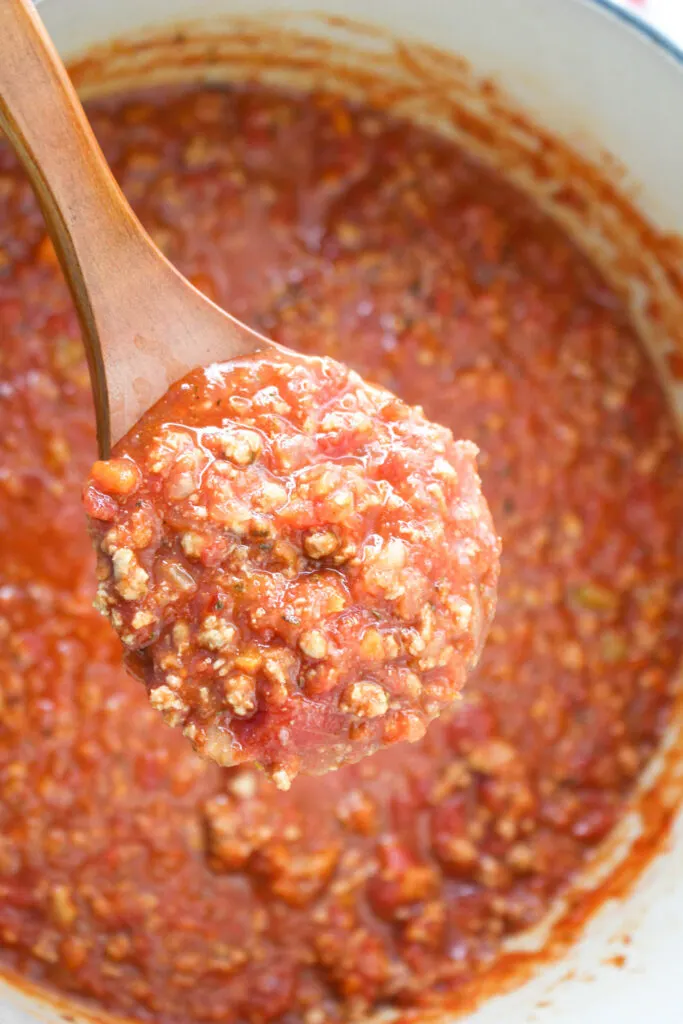
Can you freeze bolognese sauce?
Yes, homemade bolognese sauce can be frozen. In fact, it’s a great dish to make a big batch of and freeze for later use. Here’s how you can do it:
Allow the Bolognese sauce to cool completely to room temperature before freezing.
Divide the cooled sauce into portions using an airtight container or resealable freezer bags to store the sauce. This makes it easier to thaw and use only the amount you need without having to thaw the entire batch. Make sure to leave some space at the top of the container or bag to account for expansion as the sauce freezes.
Label each container or bag with the date of preparation. Bolognese sauce can be stored in the freezer for about 3 to 4 months.
To use the frozen sauce, transfer it from the freezer to the refrigerator. Allow it to thaw overnight. Once thawed, you can reheat it on the stovetop over low to medium heat until it’s heated through, give it a good stir to ensure even warming.

Traditional Bolognese Recipe FAQs
Bolognese sauce is typically made of a combination of the following ingredients:
A mix of ground beef and ground pork is commonly used to create the base of the sauce, Aromatic vegetables such as finely chopped onions, carrots, and celery are sautéed in olive oil. Canned tomatoes, tomato paste, or fresh tomatoes, a small amount of red sometimes added to enhance the depth of flavor and lend a subtle undertone to the sauce. Salt, pepper, bay leaves, thyme, and nutmeg are commonly used to season the sauce and add aromatic complexity.
Both a meat sauce recipe and Bolognese sauce are both a meat-based sauce, yet they have distinct differences. Meat sauce is a simpler tomato-based sauce with ground meat, commonly beef, and basic seasonings. Bolognese sauce, originating from Bologna, Italy, is a specific recipe with a longer cooking time. It includes a blend of beef, pork and aromatic vegetables resulting in a smoother, more complex sauce due to its extended simmering process.
Can I use ground turkey or chicken in Bolognese sauce?
While traditional Bolognese sauce uses beef and pork, you can experiment with ground turkey or chicken for a leaner version. However, keep in mind that the flavor profile may differ slightly.
Bolognese sauce benefits from a slow and gentle simmering process. It’s recommended to simmer for at least 2-3 hours to allow the flavors to meld and develop fully.
Yes, you can omit the wine if desired. While wine adds depth, you can still create a flavorful Bolognese sauce without it.
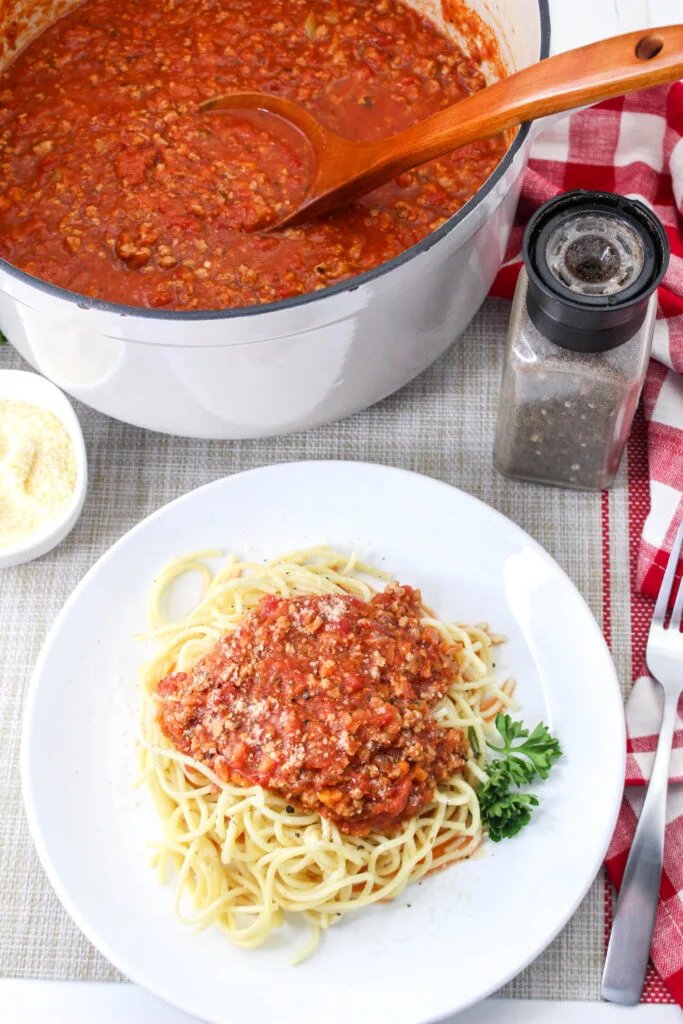

Homemade Bolognese Sauce Recipe
Ingredients
- 1/2 pound ground beef
- 1/2 pound ground pork
- 1 onion, finely chopped
- 2 carrots, finely chopped
- 2 celery stalks, finely chopped
- 3 cloves garlic, minced
- 1/2 cup red wine (optional)
- 1 cup beef broth or chicken broth
- 1/4 cup milk or cream
- 1 can (14 oz) crushed tomatoes
- 2 tablespoons tomato paste
- 1/2 teaspoon nutmeg
- 1 teaspoon dried oregano
- 1 teaspoon dried basil
- 2 bay leaves
- 1 teaspoon dried thyme
- Salt and black pepper to taste
- Olive oil
- Freshly grated Parmesan cheese (for serving)
- Fresh basil or parsley (for garnish)
- Wide pasta (tagliatelle, pappardelle, or fettuccine)
Instructions
Heat a few tablespoons of olive oil in a large pot or dutch oven over medium-high heat. Add the chopped onion, carrots, and celery. Sauté until the vegetables are softened and the onion is translucent, about 8-10 minutes.
Push the sautéed vegetables to the side of the pot and add the ground beef and pork. Break up the meat with a wooden spoon and cook until nicely browned and cooked through. Combine the meat mixture with the sautéed vegetables.
Clear a space in the center of the pot and add the tomato paste. Allow it to cook for a minute or two to develop its flavor.
If using wine, pour it into the pot and use a spoon to scrape up any browned bits from the bottom of the pan. Allow the wine to simmer and reduce slightly.
Add the crushed tomatoes and broth to the pot. Stir to combine everything. Add the bay leaves, oregano, basil, dried thyme, nutmeg, salt, and black pepper. Lower the heat to a gentle simmer.
Gradually pour in the milk or cream, stirring as you do so. The milk helps mellow the acidity of the tomatoes and adds richness. For at least 2-3 hours, cook on a very low simmer, stirring occasionally to prevent sticking.
While the sauce cooks, cook the pasta according to the package instructions. Drain and set aside.
Before serving, taste and adjust the seasoning as needed. Remove the bay leaf. Serve the sauce over the cooked pasta.
Sprinkle freshly grated Parmesan cheese and chopped basil or parsley over each plate before serving.
Serve the Bolognese sauce over a pile of perfectly al dente pasta, garnish with grated Parmesan and fresh herbs.
And don't forget about a loaf of crusty bread to dip in your sauce!
Store leftover sauce in an airtight container.
Notes
The best pasta for Bolognese sauce is one that can hold up to the richness and complexity of the sauce while providing a satisfying bite. A pasta shape that is wide and flat such as tagliatelle, pappardelle, or fettuccine, are ideal choices. These pasta varieties offer a larger surface area for the sauce to cling to.

